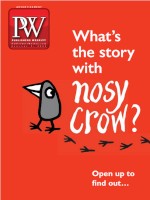Two very different women navigate a world where food is taboo in Porter’s The Thick and the Lean (Saga, Apr.).
How did you approach braiding the heroines’ stories together?
It started with the germ of Beatrice. I really wanted to explore a world in which food is taboo and sex isn’t. Growing up as a woman in our culture, especially when I was a teenager, I felt like I got a lot of the same messaging around sex and food: that I’m not supposed to have an appetite and that my body is something for other people to enjoy. So keeping oneself small and decorative. That was where the idea first came from, and the story really blossomed when I moved into other parts of that society. I set up this stratified world where, literally, the further you are from the ground, the more economic and social protections you have. That was when Reiko came to me. I liked the idea of someone who had started from the bottom, considered mortgaging her future with a large university debt to try to become middle-class, and then was smart enough to say, “I’m going to leapfrog all of that, I’m going to take my place at the top by these not-so-legal means.” Finally, several years into the writing, I made the choice to have this cookbook from a kitchen maid living a thousand years prior. I wanted to show what the culture had been like before these colonizers had come and made food pleasure taboo. That story line ended up being the bridge between the two main characters.
Tell me about the concept of hunger as holy.
We all need to consume food to be alive. And the way most of us are brought on to the planet is through sexual reproduction, sexual intercourse. Both of these things are essentially human and natural, the desire for food and the desire for sex. But not just sex, for intimacy and companionship. I love the idea of a religion weaponizing hunger in the same way sexuality has been weaponized in our different kinds of purity culture. The idea of abstaining from your own natural hunger, that doing so would get you closer to God, I thought would be very nice as an analogue to various kinds of purity culture in our day. People are told to abstain from what is natural to them, be it queerness, be it their gender expression or identity, be it a sexuality that’s not just about marriage and procreation. I heard a funny story about the man who invented the graham cracker, he did it as an anti-masturbation tool. He thought certain types of food would encourage lust.
Is this a book for foodies?
I would love it if this book was read in a foodie context. That was one of my main goals. I wanted to set it up for the gaze toward food to be quite lascivious!



 Volume 270
Issue 1
01/02/2023
Volume 270
Issue 1
01/02/2023





